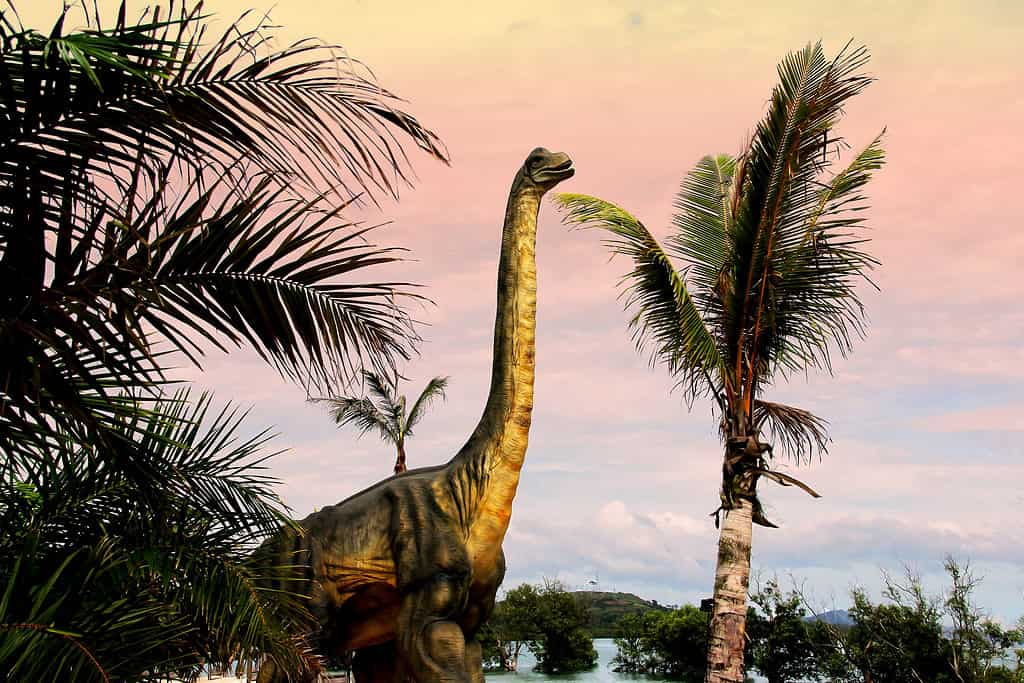Many dinosaurs were massive animals, but the most enormous dinosaurs of all were the sauropods. These gigantic creatures roamed the Earth from the Early Jurassic to the Cretaceous Periods (201 million to 66 million years ago.) They peaked in size and diversity during the intervening Late Jurassic Period, which lasted from about 174 million to 145 million years ago. If sauropods were the largest dinosaurs, what was the largest sauropod? Please read below to learn more about sauropods and the largest of them all.
Sauropods
Sauropods were giant, long-necked members of the dinosaur clade known as Sauropoda. The name comes from a combination of Greek words for lizard (sauros) and foot (poda.) They were the largest land animals in Earth’s history. Sauropoda included such well-known dinosaurs as Brontosaurus, Diplodocus, and Brachiosaurus. Members of this group had similar diets and shapes—enormous bodies with thick legs, long necks, long tails, and heads that were small relative to their physiques. There was some variation across species with spines, frills, or clubbed tails, but the basic body type was consistent.
Their size was one of their signature characteristics. The smallest members of the group were nearly 10 feet long and weighed in at about a ton. The largest species were more than 85 feet long and reached weights of almost 65 tons. Their bodies had adaptations that allowed them to reach such enormous sizes. It is believed that they had hollow backbones to offset their weight and allow for greater airflow along the neck. A hip girdle fused to the backbone by five vertebrae supported the tail and the body.

Sauropods were characterized by long tails, long necks, and small heads.
©thaloengsak/Shutterstock.com
How Are We to Judge Size?
The size of an animal is typically judged on length or weight. Since many sauropods were thought to stand on their rear legs to reach treetop vegetation, their height would be tied to their length, making length a better indicator of size. Relying only on the fossil record, weight is difficult to estimate. So, for this article, we will focus on length.
The Changing Fossil Record
Another factor to consider is the constantly changing fossil record. Many sauropod skeletons are incomplete, with some estimations based on a handful of vertebrae, femurs, or other bones. Argentinosaurus, for example, is known on the basis of vertebrae, leg bones, and a few ribs. An excellent fossil record exists for Supersaurus, so its mass and length estimates are more likely to be accurate.
Largest Sauropod in History: Supersaurus
Supersaurus is the largest known sauropod in history. The fossil record changes almost yearly as new species are discovered, and larger members of known species are found, so this achievement may be short-lived. Barosaurus and Argentinosaurus may eventually take the crown from Supersaurus if more complete remains are found, but their size estimates vary widely due to the lack of available fossils.

was the largest of the sauropods.
©HugYou/Shutterstock.com
At 105 to 138 feet, Supersaurus was longer than three school buses and nearly half the length of an American football field. For further comparison, an elephant is about 18 to 21 feet long. A Tyrannosaurus rex would only be a third as long as the longest Supersaurus. Its impressive length, however, did not give it a correspondingly extreme weight. Supersaurus was believed to weigh under 40 tons, significantly less than Argentinosaurus, which weighed up to about 75 tons.
The fossil record for Supersaurus is excellent. Fossils have been found in Colorado and possibly Portugal, with excellent specimens. So we know more about Supersaurus than any other giant sauropod, cementing its claim as the largest of all.
What Was Bigger, the Supersaurus or a Blue Whale?
The Supersaurus was the largest sauropod of all time. So, how does it compare with the largest animal of our time? Judging by length, the largest Supersaurus was over 30 feet longer than the longest blue whale (138 feet long to a maximum confirmed 98 feet.) Conversely, weight favors the blue whale, which tops out at an impressive 199 tons. Supersaurus was estimated to weigh between 35 and 40 tons.

The massive blue whale is smaller than the largest sauropod.
©Andrew Sutton/Shutterstock.com
Could Anything Prey on Supersaurus?
Their vulnerability to predators would have been similar to that of elephants. The massive size of the adults of the species made them almost immune from attack. The young would possibly have been vulnerable to predators such as the Allosaurus, but they would enjoy the protection of the larger herd. This would make it harder for a large predator to reach a juvenile. However, sauropod eggs were considered vulnerable to predators such as snakes.
Conclusion
It is incredible to think that such large animals ever walked the Earth. The largest animals we can conceive of today are whales, the largest of which is the blue whale, and even this was smaller than the Supersaurus—the largest animal ever to walk the Earth.
The photo featured at the top of this post is © 5,109 × 2,212 pixels, file size: 1.86 MB, MIME type: image/jpeg – License / Original
Thank you for reading! Have some feedback for us? Contact the AZ Animals editorial team.






